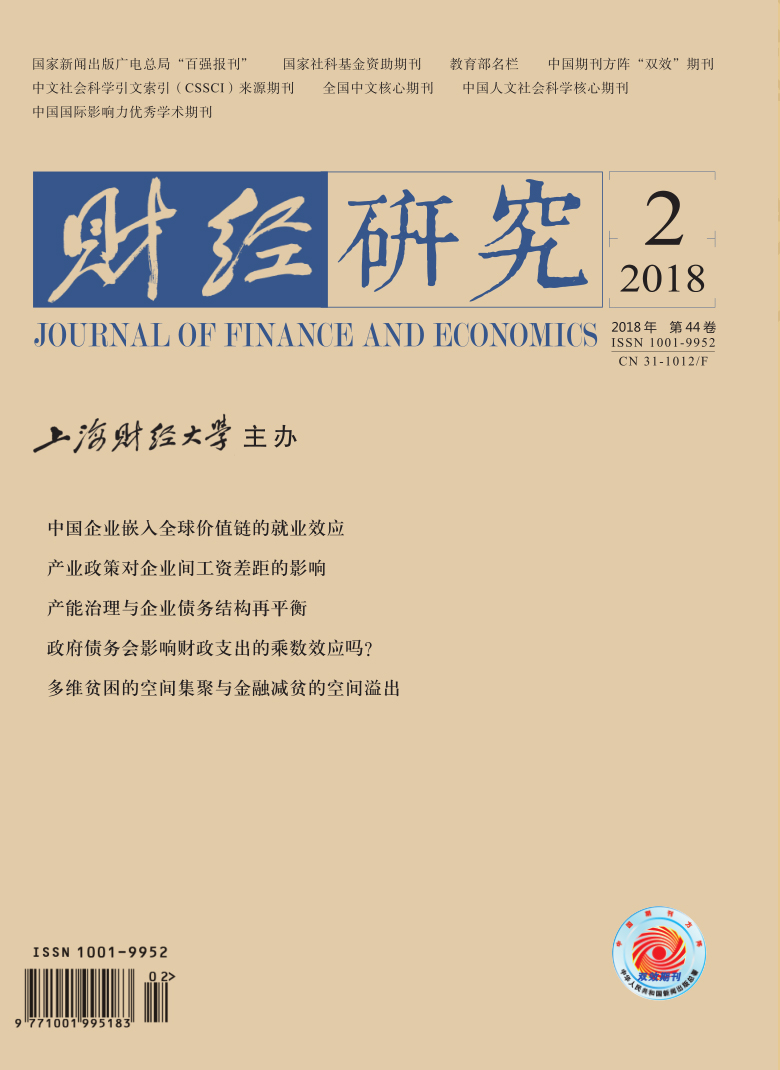我国上市制造业企业的商业信用与银行信贷关系存在长期互补特征,但信号理论对互补强度的演变过程缺乏有效的解释力。为探索信号理论之外的互补机制,反思企业债务结构的信贷偏移效应,文章提出了产能驱动假说,利用面板门限模型,得到了以下结论:(1)商业信用与银行信贷会随产能增长而呈现从“替代”到“互补”的演变特征,且互补强度(单位商业信用上升伴随的信贷上升)会随产能膨胀出现从“弱”到“强”的二次突变特征,即产能扭曲会使企业债务结构快速向银行信贷偏移,这为理解企业信贷依赖的形成路径提供了产能层面的微观解释。(2)企业债务结构再平衡能力具有异质性,高研发投资及低调整成本企业借助产能治理来修正信贷依赖的能力更强,因此降低调整成本、扶植企业创新应成为优化融资结构的重要政策路径。文章在信号理论之外提出了产能驱动假说,解释了我国企业债务结构扭曲的动态特征,并从技术创新与调整成本视角为推动企业实现债务结构再平衡提供了政策参考。
产能治理与企业债务结构再平衡——基于商业信用与银行信贷关系视角
摘要
参考文献
1 樊纲, 王小鲁, 朱恒鹏. 中国市场化指数——各地区市场化相对进程2011年报告[M]. 北京: 经济科学出版, 2011.
2 刘啟仁, 黄建忠. 产业创新如何影响企业加成率[J]. 世界经济, 2016, (11): 28—53.
4 王小鲁, 樊纲, 余静文. 中国分省份市场化指数报告[M]. 北京: 社会科学文献出版社, 2016.
7 徐欣. 企业自主研发与技术引进的协同−平衡效应——基于中国上市公司的实证分析[J]. 经济管理, 2013, (7): 47—55.
8 于博, 植率. 我国商业信用再配置的动机检验及其治理效应分析[J]. 广东财经大学学报, 2017, (4): 31—40.
10 Agostino M, Trivieri F. Does trade credit play a signaling role? Some evidence from SMEs microdata[J]. Small Business Economics, 2014, 42(1): 131—151. DOI:10.1007/s11187-013-9478-8
11 Almeida H, Campello M. Financial constraints, asset tangibility, and corporate investment[J]. Review of Financial Studies, 2007, 20(5): 1429—1460. DOI:10.1093/rfs/hhm019
13 Atanasova C. How do firms choose between intermediary and supplier finance?[J]. Financial Management, 2012, 41(1): 207—228. DOI:10.1111/fima.2012.41.issue-1
14 Baños-Caballeroa S, García-Teruela P J, Martínez-Solanoa P. The speed of adjustment in working capital requirement[J]. The European Journal of Finance, 2013, 19(10): 978—992. DOI:10.1080/1351847X.2012.691889
15 Biais B, Gollier C. Trade credit and credit rationing[J]. Review of Financial Studies, 1997, 10(4): 903—937. DOI:10.1093/rfs/10.4.903
16 Chiu W-C, Peña J I, Wang C-W. Industry characteristics and financial risk contagion[J]. Journal of Banking and Finance, 2015, 50: 411—427. DOI:10.1016/j.jbankfin.2014.04.003
17 Choi W G, Kim Y. Trade credit and the effect of macro-financial shocks: Evidence from U. S. panel data[J]. Journal of Financial & Quantitative Analysis, 2005, 40(4): 897—925.
18 Cole R. Bank credit, trade credit or no credit: Evidence from the surveys of small business finances[R]. Working Paper, 2010.
19 Cull R, Xu L C, Zhu T. Formal finance and trade credit during China’s transition[J]. Journal of Financial Intermediation, 2009, 18(2): 173—192. DOI:10.1016/j.jfi.2008.08.004
20 Dhaliwal D, Judd J S, Serflin M, et al. Customer concentration risk and the cost of equity capital[J]. Journal of Accounting and Economics, 2016, 61(1): 23—48. DOI:10.1016/j.jacceco.2015.03.005
21 Emery G W. An optimal financial response to variable demand[J]. Journal of Finance and Quantitative Analysis, 1987, 22(2): 209—225. DOI:10.2307/2330713
22 Fabbir D, Klapper L F. Bargaining power and trade credit[J]. Journal of Corporate Finance, 2016, 41: 66—80. DOI:10.1016/j.jcorpfin.2016.07.001
23 Fisman R, Love I. Trade credit, financial intermediary development, and industry growth[J]. Journal of Finance, 2003, 58(1): 353—374. DOI:10.1111/1540-6261.00527
24 Ge Y, Qiu J. Financial development, bank discrimination and trade credit[J]. Journal of Banking and Finance, 2007, 31(2): 513—530. DOI:10.1016/j.jbankfin.2006.07.009
25 Hermes N, Kihanga E, Lensink R, et al. The impact of trade credit on customer switching: Evidence from the Tanzanian rice market[J]. Journal of Development Study, 2012, 48(3): 363—376. DOI:10.1080/00220388.2011.615921
26 Huang Y, Wang X. Does financial repression inhibit or facilitate economic growth? A case study of Chinese reform experience[J]. Oxford Bulletin of Economics and Statistics, 2011, 73(6): 833—855. DOI:10.1111/obes.2011.73.issue-6
27 Kling G, Paul S, Gonis E. Cash holding, trade credit and access to short-term bank finance[J]. International Review of Financial Analysis, 2014, 32: 123—131. DOI:10.1016/j.irfa.2014.01.013
28 Kohler M, Britton E, Yates T. Trade credit and the monetary transmission mechanism[R]. The Bank of England Working Paper No. 115, 2000.
29 Lin T-T, Chou J-H. Trade credit and bank loan: Evidence from Chinese firms[J]. International Review of Economics and Finance, 2015, 36: 17—29. DOI:10.1016/j.iref.2014.11.004
30 Metlzer A H. Mercantile credit, monetary policy, and size of firms[J]. The Review of Economic and Statistics, 1960, 42(4): 429—437. DOI:10.2307/1925692
31 Ogawa K, Sterken E, Tokutsu I. The trade credit channel revisited: Evidence from micro data of Japanese small firms[J]. Small Business Economics, 2013, 40(1): 101—118. DOI:10.1007/s11187-011-9344-5
32 Petersen M, Rajan R. Trade credit: Theories and evidence[J]. Review of Financial Studies, 1997, 10(3): 661—691. DOI:10.1093/rfs/10.3.661
33 Schwartz R, Whitcomb D. Implicit transfers in the extension of trade credit[A]. Boulding K E, Wilson T F. The channels of redistribution through the financial system[C]. New York: Praeger, 1978.
34 Severin E, Alphones P, Ducret J. When trade credit facilitates access to bank finance: Evidence from US small business data[R]. EFMA 2004 Basel Meetings Paper, 2004.
35 Shaikh A M, Moudud J K. Measuring capacity utilization in OECD countries: A cointegration method[R]. Working Paper No. 415, The Levy Economics Institute of Bard College, 2004.
36 Sheng H, Bortoluzzo A, dos Santos G A P. Impact of trade credit on firm inventory investment during financial crises: Evidence from Latin America[J]. Emerging Markets Finance and Trade, 2013, 49(S4): 32—52. DOI:10.2753/REE1540-496X4905S403
37 Tsuruta D. Bank loan availability and trade credit for small businesses during the financial crisis[J]. The Quarterly Review of Economics and Finance, 2015, 55: 40—52. DOI:10.1016/j.qref.2014.09.004
38 Yang X. The role of trade credit in the recent subprime financial crisis[J]. Journal of Economics and Business, 2011, 63(5): 517—529. DOI:10.1016/j.jeconbus.2011.05.001
引用本文
于博, GaryGang Tian. 产能治理与企业债务结构再平衡——基于商业信用与银行信贷关系视角[J]. 财经研究, 2018, 44(2): 29–43.
导出参考文献,格式为:





 8070
8070  7471
7471

